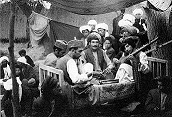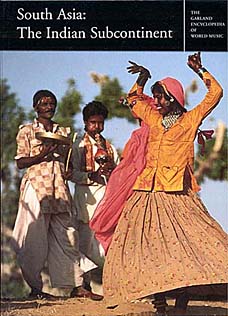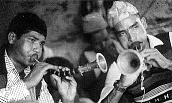|
New York:
Garland
Publishing, Inc., 2000. |
Vikram Sheth’s celebrated stanza seems to point at this attractive compilation of ethnomusicological research on South Asian music even more than at his own substantial novel, A Suitable Boy: not even two kilos. The Garland Encyclopedia of World Music, Volume 5 is a generous two-and-a-half kilos of solid scholarship. This formidable piece of work should be every ethnomusicology student’s pillow-book, were there not the likely risk of spraining one’s neck as well. A combined effort of sixty-eight authors from fourteen different countries, the origin of the contributors reflects the overwhelming interest South Asian music has been enjoying among American ethnomusicologists: Forty of the authors are from, or based in the United States, with only six based in South Asia. This disparity should not mislead us. Scholarship on Indian music and dance began almost eighteen hundred years ago, and continuing respect and interest have produced a massive body of literature in Sanskrit and vernacular languages, mostly on the two great traditions of Hindustani and Karnatak music. Increasing Western interest in Indian music during the past two hundred years has resulted in a multitude of international authors, different approaches and diversified publications. Since the 1960s, Western ethnomusicologists have accumulated an impressive amount of degree theses on many aspects of South Asian music. In India and its neighbour countries, relevant publications in English and local languages abound. Editor Alison Arnold took exemplary care in presenting this impressive extract of our present knowledge about South Asian music and dance in a way appealing both to scholars and to a much broader audience searching information on: music making and music theory, musicians and dancers, performers and audiences, musical transmission, mass media, and many other topics. In accordance with the concept underlying each volume of this encyclopedia, the matter has been organised in three parts.
Part 1 introduces the region of South
Asia as a whole, first in an overview profile of its geography, society,
cultures, religions, and history and then examining the history of musical
scholarship. |
|
|
|

Part 3 examines the following music regions of South Asia
and the Himalayas: Gujarat, Rajasthan, Punjab, Uttar Pradesh, Mithila,
Kashmir, Nepal, Tibetan diaspora in South Asia, Madhya Pradesh, Maharashtra, Orissa, Goa, Pakistan, Afghanistan
(Figure 2: music-making in Afghanistan), Bengal, Karnataka, Andhra Pradesh, Tamil Nadu, Kerala and Sri Lanka. Each chapter
is followed by a select bibliography. The articles combine the meticulous
precision you would expect from an encyclopedia (see for example
"Theoretical
Terms and Concepts in the Hindustani Raga
Tradition"
by Richard Widdess), with the aim of being comprehensive. |
|
|
|
|
|
The northeastern area of India (Assam, Arunachal Pradesh, Meghalaya, Tripura, Mizoram, Manipur, Nagaland), which is particularly rich in diverse ethnic groups, has not been covered at all in this publication – except for a few dance traditions. Students of ethnomusicology, please prick up your ears! These are important topics awaiting systematic study and the results should be included in the next edition of The Garland Encyclopedia of World Music. How much would I have loved to carry this wonderful book in my backpack thirty years ago when travelling to South Asia in search of inspiring music! Never mind two-and-a-half kilos, if they can give so much relevant information and are such a joy to read. If you cannot afford to buy it, pinch it! [Review Editor's note: He's just kidding. Please don't pinch it.] review | EOL 8 | email author | editor released 11 December 2002 |
|



